Maserati
|
1914 - present |
Country: |
 |
|
Neptune’s
Trident, The Ancient Symbol Of Bologna
One of six brothers, Alfieri Maserati
founded the now famous marque in the mid 1920’s
at Bologna. As the symbol for his new car he chose
Neptune’s
Trident, the ancient symbol of Bologna and the location
of his works factory.
Until the outbreak of war in
1939 the vast majority of Maserati’s were single-seater
race cars, while the company did manufacture a handful
of two-seater sports-cars (again with the intention
of racing them).
The first Maserati, the “Tipo
26” was
produced on the 14th April, 1926. But the first notable
car to leave the factory was the 8C-1100 of 1929;
sitting upon an 8ft 2in wheelbase the car featured
a supercharged 1087cc twin-overhead camshaft engine
good for 100bhp at 5500rpm and giving the car a top
speed of more than 80mph.
While the 8C-1100 was successful
in some minor Italian races, Alfieri developed an
even more powerful version that used a 1492cc engine
good for 120bhp. Both versions used square-rig bodies
with raked-back radiators, while their fuel tanks
were housed in a tapering tail.
In 1930 the 4CTR-1100
appeared, featuring a 1088cc twin-overhead-cam engine
fitted with a Rootes-type supercharger blowing through
a Weber carburettor. Performance was ensured by keeping
the weight of the car down, the 4CTR tipping the
scales at a relatively low 1360lb.
Ettore And Ernesto Take The Helm
But tragically
Alfieri Maserati would pass away in 1932 – leaving
the running of the business to two of his brothers
Ettore and Ernesto. While still very much concerned
with the development of racing cars, the brothers
also believed that, to ensure commercial success,
they would need to manufacture a road car with broad
consumer appeal.
Of course the war would intervene
in their plans, and so the first semi-production
Maserati road car would not appear until 1947, following
a company restructure that would see the “Orsi”
group assume ownership with Ettore and Ernesto retaining
senior partnership roles with the company.
The A6/1500
model had a simple ladder-type layout, including
three inch tubular side-members, with cruciform and
lateral cross-bracings. Independent front suspension
was by coil springs and wishbones, while at the rear
the rigid axle was suspended on coil springs with
radius arm location.
A far simpler power plant was
chosen for the production car (ease of maintenance
and robustness being virtues any immediate post war
production car would require), in this instance a
1488cc six cylinder unit good for 65bhp at 4700rpm.
The engine was closely modelled on the 1936 racing
unit, but without the supercharger attached the engine
would remain unstressed and ever-reliable.
Beautiful, Aerodynamic, Farina
But perhaps
the most important feature was the body style, modelled
by Farina. Not only was it beautiful, it was also
very
aerodynamic and, even though the engine was
perhaps a little underpowered, made the A6 good for
a top speed of around 95mph. The direct development
of the A6 was the A6G/2000 range, built from 1951
to 1957, the series 1 having a single-cam 1954cc
engine, while the series 2 (from 1954) used a twin-cam
150bhp 1985cc engine.
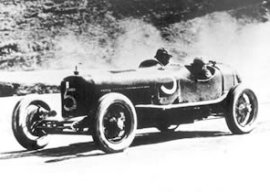
The Maserati Tipo 26 may have been the first,
but was not the most noteable...
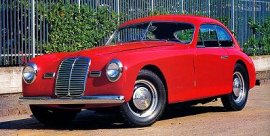
The A6/1500 had a beautiful body styled by
Farina...
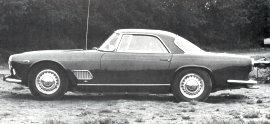
The 3500GT was the first Maserati to be built
in any sort of quantity...
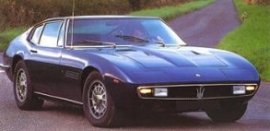
Styled by Giugiaro, the Ghibli was based on
the four-door “Quattroporte” saloon
- then the fastest saloon car in the world...
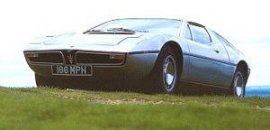
The first Maserati to be manufactured after
Citroen took control, the Bora used the same
Maserati engine as was designed for the SM...
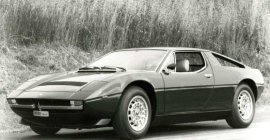
The Merak used a smaller V6 engine, but the
space saved was put to good use by the designers
with the inclusion of an occasional 2+2 seat
configuration...
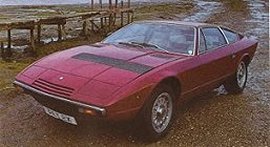
The Khamsin was the last model to be released
prior to the De Tomaso take over...
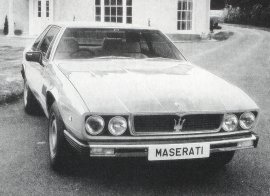
The 1980 Maserati Kyalami, based on the four-seater
"Longchamps" after De Tomaso took
control... |
Both motors were born from
race track, being de-tuned examples of the Formula
2 design of the day. Rear suspension on the series
2 cars had cantilever leaf springs and radius arms,
and a top speed of just under 120mph. Growing tired
of the involvement of the Orsi group, and buoyed
by the success of the A6 and A6G, Ettore and Ernesto
decided to leave Maserati and start-up their own
company, “Osca”.
The 1950’s
would see the company continue to trade under the
Maserati name, despite having no involvement with
the family.
Despite the loss of their links to the
past, the factory continued to develop both Formula
2 and Formula 1 race cars. Their road-going 300S
sports-car was closely based on the F l design, using
the same type of twin overhead camshaft six-cylinder
engine good for 260bhp and giving it a top speed
over 160mph. Despite its awesome performance,
the decision was made to squeeze a new four-cam
4.5 litre V8 engine into the same basic chassis.
The result was the brutal 450S, which had more than
400bhp on tap – giving
it blistering performance but, strangely, only limited
success in competition.
The Maserati 3500GT
The first Maserati road car
to be built in considerable numbers was the 3500GT.
Launched in 1957; it would not be officially on sale
until 1958. The 3.5 litre twin-cam six cylinder engine
was derived from their race cars, had an 8.5:1 compression
ratio, triple twin-choke Weber carburettors and good
for 230bhp at 5500rpm and a top speed over 140mph.
The
chassis was a complex affair, partly tubular, partly
stiffened by pressed steel members, with coil spring
independent front suspension, but the rigid rear
axle was suspended on half-elliptic leaf springs,
with extra radius arm location.
There were drum brakes
at first, but a Girling disc setup followed in 1960.
Carrozzeria Touring and Allemano built the first
batch of bodies, and some 100 were completed in 1959,
the first complete production year. Coupe and drop
head styles were both available.
In 1962, Maserati
broke new ground, by offering a revised version of
the car, the 3500GTI, which was fitted with “Lucal” fuel
injection. Although this only produced another 5bhp
in peak performance, it made the car both more flexible
and more fuel efficient.
An even more exciting Maserati
road car was first shown at Turin in 1959, the very
limited-production (only 32 produced) 5000GT.
Using
the same chassis and suspension layout as the 3500GT,
the 5000GT had a 4935cc version of the racing V8,
detuned a little for road use, but still producing
a very healthy 330bhp at 5700rpm. Needless to say
the 5000 was extremely expensive!
A revised six-cylinder
road car, the “Sebring”,
was introduced in 1963. Developed directly from
the 3500GTI rolling chassis, it had a “Vignale”
2+2 coupe body, and was shorter, by four inches,
than the previous model. Good for 235bhp at 5800rpm,
it could reach 137mph, and achieved 16.4 seconds
for the 1/4-mile.
In the same year Maserati also
launched their stylish
“Mistrale”, again using 3500GTI/Sebring
mechanical components, but with a neat fixed head,
or convertible, style by “Frua”.
Initially
the car had a 3.5 1itre engine, but later there was
a 3692cc/245bhp six, and eventually a 4012cc/255bhp
option, this being the final stretch of the long-serving
twin-cam unit, descended from the early 1950s single-seater
racing unit. This last iteration made the Mistrale
good for a top speed of 155mph!
Next came the
Ghibli,
a startlingly beautiful two-seater fastback coupe,
styled by Giugiaro when he was working at Ghia.
Introduced at the 1966 Turin show of 1966, the Ghibli
was fitted with either a 4719cc/330bhp or 4930cc/355bhp
four-cam V8 engine.
The Ghibli’s
chassis design was based on the larger four-door “Quattroporte” saloon
(then the fastest saloon car in the world) and
its shorter-wheelbase derivative, the Mexico.
Even
though, or perhaps despite the fact that the Ghibli
still used a rigid rear axle with half-elliptic
leaf springs, it would provide extremely popular
(for such an expensive
“exotic” supercar), with some 1274 being
manufactured before production ended in 1973.
The Vignale Indy, The First Maserati To Have a Unit Construction Body
The
Indy of 1969-75 was, strictly speaking, not a traditional
sports-car. The sleek fixed head style by Vignale
offered 2+2 seating, but more importantly was the
first-ever Maserati to have a unit construction body.
Although it looked a little like the Ghibli, the
two cars were structurally very different.
Indy models
were equipped with either a 4136cc/260bhp or 4719cc/330bhp
engine, and were good for top speeds in excess of
150mph. But the development of super-cars is an expensive
passion, so much time and money required for research
and development, with the resultant product being
priced so that only a handful can afford them. And
so, in 1969, Orsi sold the company to Citroen.
The
first true 'Citroen-controlled' Maserati was the
mid-engined
Bora coupe of 1971. In the evolving fashion
of the day, this was a mid-engined car featuring
a 4.7 litre V8 longitudinally mounted and fitted
with quad twin-choke Weber carburettors mated to
a 5 speed ZF transaxle. There was coil spring independent
suspension and disc
brakes all round, which gave
good roadholding, but rather a firm ride.
Giulio Alfieri, Father To Many Famous Maserati Models
The Bora’s
styling was by Giugiaro, and engineering was led
by Giulio Alfieri, the 'father' of so many famous
Maserati models. It had a steel unit construction
body/chassis structure, and the Citroen influence
was evident in the cars “hydraulic plumbing”.
It was a heavy machine - weighing almost 4500lb with
two passengers, their luggage, and a full 20 gallon
petrol tank. On the other hand, engine was good for
310bhp at 6000rpm giving it a top speed of 162mph,
and even though cars like the
Jaguar E-Type could
out-sprint it to 120mph, it was still a success.
Developed
from the Bora, and first shown at the 1972 Paris
salon, the
Merak shared a virtually identical chassis
platform, and style, but was powered by the 2965cc
90 degree four-cam V6 engine which Maserati had
already developed for the
Citroen
SM Coupe. In the
Merak, the engine featured triple Weber carburettors
and was good for 190bhp at 6000rpm.
Because the V6
was slightly shorter than the V8 Maserati were able
to extend the cabin, just enough to incorporate
two tiny seats for small children. And while the
smaller engine made the Merak some 200lb lighter
than the Bora, it was not nearly as powerful and
made the early model Merak’s good
for a top speed of only 135mph, while in the 0-60mph
dash it was almost 2 seconds slower!
A later development
was the Merak SS, which had a more powerful 220bhp
engine and a top speed of more than 150mph – and
in recognition of the luxury deemed mandatory for
any car with US export intentions Maserati fitted
the car with air-conditioning. When Peugeot took
over Citroen the writing was on the wall for Maserati.
Ownership Changes Hands, Again
The Peugeot rationalisation plan called for the
dumping of the wonderful Citroen SM, and then the
withdrawal from Maserati. Liquidation followed,
but Alejandro de Tomaso would come to its rescue
and merge it with his company. He would go on to
develop a re-engined version of his Longchamps,
the V8 powered Maserati “
Kyalami”. Fiat
would go on to take control in 1993, and then Ferrari
would acquire 50% of the company in 1997 and, effectively,
total management control.
Also see:
Maserati 450S V8 |
Maserati Racing Heritage |
O.S.C.A |
The Story Behind The Rise of Neptunes Trident (USA Site) 


